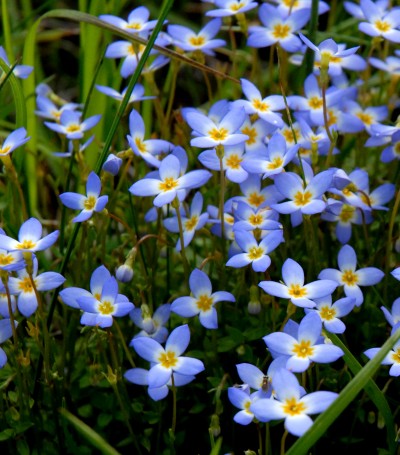Prostrate Bluets Credit Vicki Dameron.jpg
 Prostrate bluets on the Blue Ridge Parkway. Photo by Vicki Dameron
Prostrate bluets on the Blue Ridge Parkway. Photo by Vicki Dameron We can’t say it loud enough: thank goodness for spring! The promise of refreshing walks in the woods, colorful blooms, and a greener landscape on the Blue Ridge Parkway are bright spots during these stressful times. If you’re headed out to appreciate the diverse wildflowers that herald the season’s arrival, we have tips for best viewing and staying safe.
To plan your wildflower excursions, look to the trees for signs of the best opportunities. When leaves begin to bud, it’s a good time to head out. Don’t miss the cue, because once the leaves begin to fill in the canopy, the flowers are fading, explained Chris Ulrey, plant ecologist with the Blue Ridge Parkway.
There are more than 1,600 vascular plants that call the park unit home, and about 80 percent are wildflowers, according to the National Park Service. The abundant rainfall, moderate climate, and diverse habitats, from fields and forests to ridges and coves, contribute to the wondrous variety of Appalachian flora. Bloom times vary greatly depending on elevation and direction of the slopes, so if you miss a flower bloom at a lower elevation, you can still catch the show at a higher vista. “As you go up in elevation, you go back in time,” explained Chris Ulrey, plant ecologist with the Blue Ridge Parkway. “Spring starts in the valleys and finishes on the peaks. A flower can be blooming on a peak a month behind the lower elevations.”
When you set out to see the colors that dot the trails, be mindful to:
· Give others space and time. Even in the outdoors, social distancing is important. Health officials recommend staying at least six feet apart. That means, you might need to be patient as others pause to enjoy a view or take a photo. On the flip-side, don’t linger and be sure to step aside to allow others to continue their journey.
· Keep it small. Now is not the time to plan a hike for a group of friends. Your adventure should be reserved for people within your household.
· Step lightly. One of the greatest dangers to plants is being trampled by visitors. It’s best to stick to the marked trails, avoid shortcuts, and make sure dogs are kept on a leash.
· Let it grow. As tempting as it might be to pluck a bloom or even transplant a sprout, resist the urge: it’s illegal. Instead, snap a photo and take it to your local garden center to find a propagated specimen for your landscape.
· Leave no trace. Minimize your impact on the natural environment. Be sure to pack out any items or waste you bring in. Read more about The 7 Principles of Leave No Trace.
What You’ll See
The flowers to discover in March and April include dwarf iris, spring beauty, buttercups, Solomon’s seal, pinxter flower, and squirrel corn (yes, that is a flower name!). During May and June, you’re likely to see pink shell and flame azalea, bluets, columbine, fire pink, phlox, mountain laurel, wild geranium, dogwoods, Virginia spiderwort, Turk’s cap lily, and many more. As summer takes hold, look for black-eyed Susan, tall coneflower, Oswego tea, bellflower, and pokeberry, among others.
To learn about the showier blooms on the Parkway, click here.
To download the Blue Ridge Parkway’s bloom calendar, click here.
If you can’t get out on the Parkway right now, explore this flower photo gallery.
Be well, and enjoy the beauty of your national park.